The Affordable James Bond Wardrobe: Suits
In this entry for our Affordable James Bond Wardrobe series, we going to cover what you need to know when you’re buying a suit. Because let’s face it: 007 and tailoring have gone hand in hand since the very beginning of the franchise. One thing that’s often overlooked but is vital when buying a suit (no matter the price) is the fitting. Every man is different, so no suit will fit perfectly unless it is made to measure. All good tailors and clothing companies will measure and customize the fitting of your suit. Some, like Damiani, will even let you customise the fabrics, patterns and textures too. There’s a lot to cover so let’s get started!
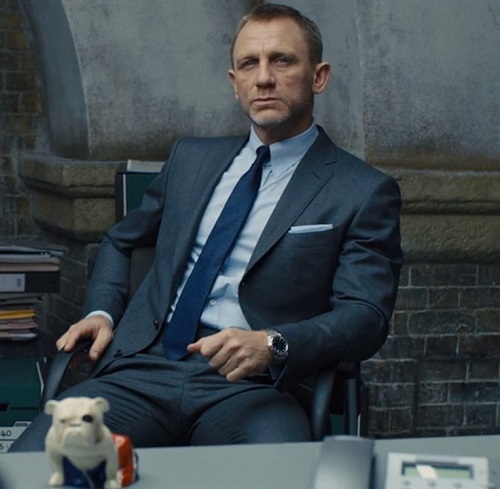
Suit Jacket Construction
A suit jacket is made up of three layers: the outer fabric, the interlining and the inner liner fabric. When it comes to the basics of suit construction, we mainly want to focus on that middle layer. The jacket’s interlining is a piece of material that runs from the shoulders down the front of the jacket almost the hem. What matters is how the interlining layer is made and how the outer fabrics attaches to it. There are three main interlining construction methods: full canvassed, half canvassed and fused.
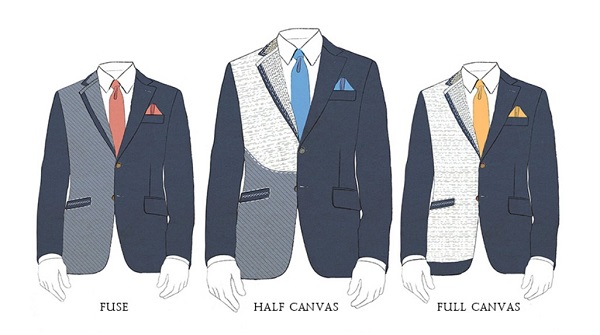
Fused construction
This is the least expensive way to make a suit jacket. A fused interlining is normally different layers of fabric bonded together with an adhesive and heat to create one piece of material. The outer fabric is then bonded onto the fused interlining to give the jacket its shape. Now, just in case you’re thinking that fused construction is only used by low-end brands, you should know that some higher-end fashion labels also make some of their suits this way.
Pros: Inexpensive. And fusing construction methods have improved over the last decade to create a more natural drape and increase durability.
Cons: Even at the higher-end, fused jackets tend to look (and feel) very stiff. You never get the same form fitting feel that a canvassed jacket gives you. And when you take the jacket to be cleaned, the high heat used by most dry cleaners can cause the outer fabric and fused interlining to delaminate, which creates unsightly “bubbles” across the front. Once those appear, there’s nothing you can do to get rid of them.
Half Canvassed
A half-canvassed construction starts with a lightweight material fused to the outer fabric. But below that, the suit maker stitches in a layer of higher quality canvas across the upper half of the jacket and then stitches in the chest piece to give the jacket its shape.
Pros: Less expensive than a full canvassed jacket. And it’s a construction method being used by more and more smaller brands to deliver very good value for the money. The stitched in canvas and chest piece allow for a more natural lapel roll and a softer fit that will conform to your body over time.
Cons: Because the outer fabric is still fused to an interlining, there’s a risk of delamination and bubbling when you get the jacket dry cleaned. The half-canvassed jacket will also feel a little stiffer than a full canvassed jacket.
Full Canvassed

With a full canvassed suit, layers of horse hair and wool canvas are strategically stitched to the outer material and lapels to give the jacket its shape. With the possible exception of some of Timothy Dalton’s jackets, all of Bond’s suits have been made by tailors using a full canvassed construction.
Pros: It’s the best way to make a suit jacket. Because the canvas is stitched in (instead of glued), the jacket can move more easily with your body. So it’s more comfortable. The natural canvas will also form to your body with wear, so the fit just keeps getting better. And, because no heat activated adhesives are used, there’s no chance you’ll get ugly bubbles when you get it dry cleaned.
Cons: It ain’t cheap! And, depending on the weight of the canvassing materials used, the jacket may feel a little stiff and heavy at first. However, this goes away with wear as the jacket molds to your torso.
What type of construction should you buy?
![]()
Let’s be practical and start with a question. How often do you wear a suit? If your work requires you to wear a suit every day (or you just love wearing suits), saving up for a full canvassed one can definitely be worth it. It’ll fit better and last longer. If you just need a suit for weddings, graduations or some other once or twice a year event, a higher quality fused suit will work fine. I honestly don’t see much point in having hundreds (or thousands) of dollars just hanging unused in your closet. That’s money you could invest in something you actually wear on a day to day basis.
But in my opinion, half canvassed suits are really the sweet spot for most men right now. They’re not overly expensive. Makers like Charles Tyrwhitt, SuitSupply, Spier & Mackay, Black Lapel and many others offer half canvassed suits with good quality fabrics in contemporary styles in the $300 to $600 range. They’re more comfortable to wear than a fused jacket. And some companies allow you to customize certain style and fit details (pocket style or sleeve length for example) so you can really get the suit you want.
And remember: as we stated in the second article in this series, buy the best you’re going to wear, not the best you can afford!
How a Suit Jacket Should Fit
![]()
1 – Shoulders
The top of the shoulder seam should line up with the outside of your shoulder muscle (deltoid). This allows the upper part of the sleeve to hang straight for a cleaner look. The easiest way to test shoulder fit is the “Wall Lean”. Stand perpendicular about 8″ away from a wall with your arms hanging straight down your sides. Slowly lean into the wall. Your shoulder and the jacket shoulder should touch the wall at the same time. If your shoulder touches first, the jacket is too small. And if the jacket shoulder touches first, it’s probably too big.
A quick note on shoulder padding. The trend today (which I quite like) is for softer, more natural shoulders with less padding versus the highly padded and structured jacket shoulders we see on Brosnan’s and Craig’s Brioni suits. That’s not to say there should no padding in the shoulders! But avoid jackets with shoulders that stick out perpendicular to your neck or extend beyond your natural shoulder.
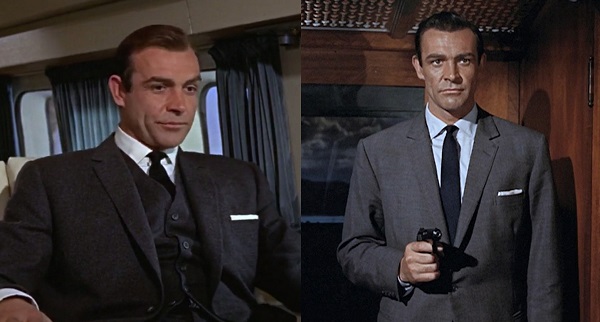
2 – Arm hole/Armscye
Make sure the armscye (where the sleeve joins the body of the jacket) is the correct fit from the start. A higher and tighter armscye is in fashion right now. But it can be uncomfortable for someone with a bigger back or shoulders. It will feel like your range of motion is restricted. On the other hand, a lower and wider armscye can make the jacket fit look sloppy on a thinner guy. And a poor fit here can cause other issues, such as exaggerated “dimpling” at the shoulder, collar gap and pulling or bagginess across the chest.
3 – Sleeves
For a few years now, super tight sleeves have been the fashion. Thankfully, that trend is ending and fuller sleeves are coming back into style. You want the sleeve fabric to closely follow the line of your arms when they’re hanging straight at your sides. But you shouldn’t feel any binding or pulling when you walk or bend your elbows.

You should also consider the “pitch” of the sleeve (the angle at which it’s sewn into the armscye). The sleeve angle should match the angle of your upper arm. If there’s a misalignment between the sleeve pitch and your arms, you can see issues like shoulder divots or pulling across the back of the jacket.
4 – Cuffs
One of the most common fit problems guys have with suit jackets is sleeves that are too long. The sleeve cuff should end right around your wrist bone. This allows you to show off a little bit of shirt cuff. It may seem like a small thing, but it really ups your style game when you get it right.
5 – Collar
Another big fit issue is the collar gap, when the collar of the suit lies away from the collar of your shirt. There’s several other fit problems that can create a collar gap (see above). So think of it more as a symptom of poor fit rather than a separate issue. Ideally, you want the collar of the jacket to lie as close as possible to shirt collar, with little or no space between them.
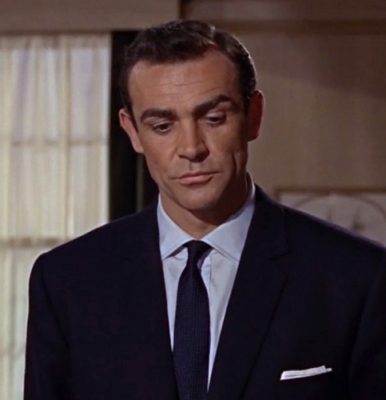
6 – Lapels
Probably nothing dates a suit faster than the lapel design. We all know that super thin lapels with a very high gorge (the point where the lapel is sewn to the collar, creating the notch) have been in fashion. But the trend is quickly turning back to fuller, wider lapels. So if you’re buying a “timeless” suit, play it safe and go with lapels somewhere between 2.75″ to 3.5″ wide. Smaller guys can go with lapels on the narrower end of the range. Bigger guys can go with lapels on the wider end. The center of the gorge should line up approximately with the tops of your shoulders.
7 – Body
Two main things to think about here. First, the fit through the chest. With the correct fit, the lapels will lie flat down your chest when the jacket is buttoned. There also shouldn’t be any loose fabric or billowing under the arms (“Bat Wings”). Second, the button stance. This describes how high or low on your torso the main buttoning point lies. It’s also a factor in determining the length of the lapels.

Whether you’re using a button three, a button two or a three-roll-two jacket, you want the button stance to sit close to the line of your natural waist (the narrowest part of your torso between the bottom of your ribs and the top of your hip bones). This stance allows for longer lapels and a deeper “V” that helps elongate the body and shows off more of your tie. You also want to avoid the dreaded X: those wrinkles in the suit front radiating out from the fastened button. If you’re getting those it means the jacket is too tight at the waist.

8 – The Skirt
This is the bottom half of the jacket. We have three things to consider here. First is the length of the jacket. The main rule of thumb is the jacket should be long enough to cover your backside. However, gentlemen that are under 5’9″ may choose a length that’s a little shorter to help give the appearance of longer legs. Just make sure the majority of your butt is still covered! Second, the vents. My personal preference is for double vents. I just feel they help the jacket drape better from the waist down and better cover my backside when I’m moving. But there’s nothing wrong with being a single vent kinda guy.
Third is the design of the jacket below the button stance, also called the jacket “quarters”. The trend lately has been to cut the quarters in an “open” style, creating an inverted V below the fastened button that exposes some shirt, the bottom of your tie and the top of your trousers. I have no idea why this is a thing right now. But there’s no arguing that a jacket with closed quarters, with the fabric overlapping below the fastened button, is a cleaner and more classic look. And it also helps elongate the body to give the appearance of height and/or less bulk around the waist.
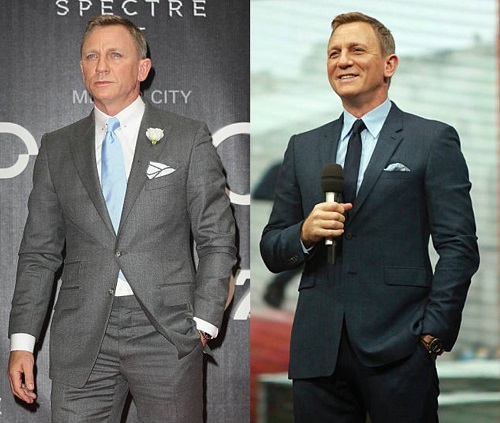
Yes, there’s a lot to consider when selecting your suit jacket. The good news is that you can make some adjustments after you’ve purchased your suit to really dial in the fit. It’s just a question of knowing what has to be close to perfect from the start and what a tailor can fix later.
What can’t (and can) I have tailored?
It’s very rare that a suit jacket will fit you perfectly off-the-rack. And even made-to-measure suits will usually need a few tweaks, especially if it’s your first one. So expect to get any suit tailored for a perfect fit. It’s worth the investment. An inexpensive but properly fitted suit is always going to look better than an expensive suit that fits poorly.

Having said that, there are some things that are easy to fix and others that will require some serious (and expensive) work by a professional. So consider the following when you’re trying on suits.
Extremely difficult (and expensive) to tailor
- Poorly fitting jacket shoulders are almost impossible to fix (unless you want to spend a small fortune to have a professional rebuild the jacket). First rule of suit buying: if the shoulders don’t fit, don’t buy the suit.
- Same for increasing or decreasing the size of the armscyes. If the jacket feels too tight or too loose around the armholes, look for another suit.
- Cuffs with working buttons (sometimes called a “surgeon’s cuff”) make shortening the sleeves a pain. Normally, you can shorten sleeves with working buttons no more than a half to three quarters of an inch from the bottom of the sleeve. More than that and the edge of the sleeve gets too close to the bottom cuff button, which just looks weird. If your jacket has surgeon cuffs and you need to shorten the sleeves by more than three quarters of an inch, a professional tailor will need to remove the sleeve from the armscye, cut away the excess length from the top and reattach it. In other words, it’s a major (and expensive) undertaking.
- As for lengthening sleeves with working cuff buttons, you’re pretty much restricted by the amount of extra fabric inside the cuff. And having the sleeve edge too far away from the bottom cuff button also looks weird.
- Since button holes are basically … well .. holes in the suiting, there’s not much you can do to change button stance.
- The height and shape of the gorge and the width of the lapels are also pretty permanent. Best make sure you like the lapel style as it is.
- Closing the quarters (so the fabric overlaps under the button point) is also very difficult, since open quarters are part of the inherent design of the jacket.
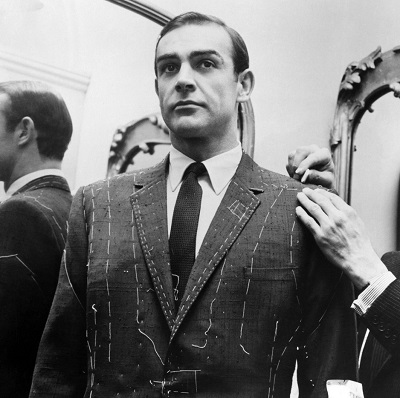
Moderately easy to tailor (but you want it done right!)
- Sleeves can be narrowed and it isn’t usually an overly difficult job. The key is making sure you can have the adjustments done without having to mess around with the armscyes. Usually you’ll be okay if you stick to narrowing the sleeves less than three quarters of an inch, starting about 2 inches away from the arm hole. Three quarters of an inch may not sound like much. But it can make a big difference in the overall appearance of the jacket.
- Bringing in or letting out the sides of a jacket so it fits better through the chest and waist also isn’t particularly difficult work. Again, the question is how much you need it adjusted. The skill really lies in making sure the fit of the jacket stays consistent and the stitch work looks clean. It gets more complicated if the tailor needs make changes in the area of the canvasing.
Easy to tailor
- If you bought a jacket with non-functioning cuff buttons, shortening or lengthening the sleeves is a much easier process. Even better if the cuffs don’t have that faux button hole stitching. All that can be added once you’ve had the sleeves properly adjusted.
- Adjusting the jacket length by about an inch really isn’t much of challenge for a competent tailor. The difficult part is maintaining the shape or curve at the bottom corners of the quarters.
Suit Trousers
Compared to the complexity of the jacket, the suit trousers are a relatively short discussion. We’ll start by discussing the fit and some style details.
![]()
1 – The Waist
The big question here is belt loops, suspenders or side tab adjusters? Even though Brosnan used a belt with many of his suits (and it’s considered normal practice in the U.S.), Bond most frequently favored side-tab adjusters. If you can find a maker that offers them (and many smaller Made-to-Measure boutique brands now do), then give them some serious thought. They’re one of those small details that elevates Bond’s style compared to those around him.
But larger gentlemen carrying some weight around the waist may also want to consider using suspenders (or braces). I honestly can’t recall Bond ever using them with a suit. But this is more about your comfort than getting every detail exactly right. Just remember: never use suspenders and a belt at the same time!
2 – Pleats or flat front
Before you make a snap decision, let me tell you that pleated trousers are making a serious comeback. And Bond used pleated trousers more than flat front trousers throughout his history. There are also fit advantages to using pleats. They provide more room around the hips to help with ease of movement, while still allowing the trouser legs to drape properly. This, again, can be nice for larger guys. But if flat front trousers are your thing, then go for it.
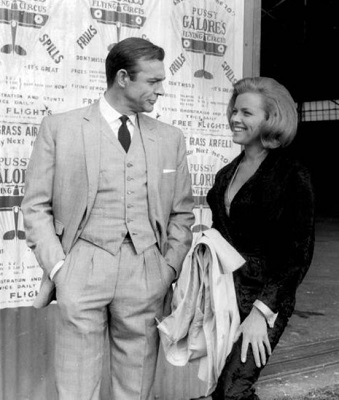
3 – The Rise
The rise describes the trousers’ front length from the middle of the crotch seam (between your legs) to the top of the waistband. Lower rise trousers will have a rise between 8″ and 10″. Higher rise trousers are usually between 10″ and 12″. The current fashion tends towards lower rise trousers. But rather than worrying about what’s currently in style, focus more on what works best for you. You want the top of the trousers to sit just above your hip bones. And the fit through the hips and seat should be comfortable, with no binding or stretching when you’re walking or sitting down.
Tailoring the waist, hips and seat on a pair of trousers is not overly difficult as far as sewing goes. But it does take a trained eye to ensure that everything stays in proportion and the drape isn’t affected. So best take this kind of work to an experienced professional.
4 – Leg Fit and Taper
If you’ve nailed the fit in the top half of the trousers, then the legs should drape naturally down to the cuff, following the line of your legs. That does not mean there should be an excess amount of fabric billowing around your legs. Contemporary style favors a trimmer cut with more of a taper. But you should also avoid low rise, “skinny fit” trousers that are too tight through the legs. Yes, that style shows up a lot on Instagram. But it’s a trend that’s quickly dying.
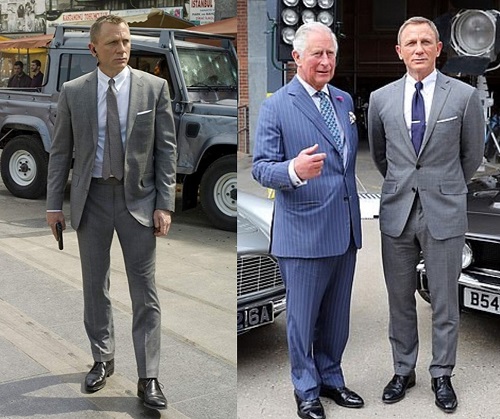
This would be a good time to note that having trousers tapered by a tailor is a relatively simple process. So focus on the trouser fit in the waist, rise, hips and seat and don’t worry too much if they’re a little too loose or baggy through the legs.
5 – Length and Cuff
We’ve already covered trouser length and break in our post on Pants and Belts. To summarize: some type of break is appropriate on suit trousers if it works with your height and doesn’t affect the drape of the trousers. If you’re over 5’10”, a quarter break should do it. If you’re under 5’10” go with no break.
As for trouser cuffs, I’m of two minds. Cuffs add weight to the bottom of the trousers which can help the fabric drape better. But they can also make our legs appear a little shorter. Which isn’t something any guy 5’9″ and under wants. If you like them, give them a try. But there’s no harm in not using them.
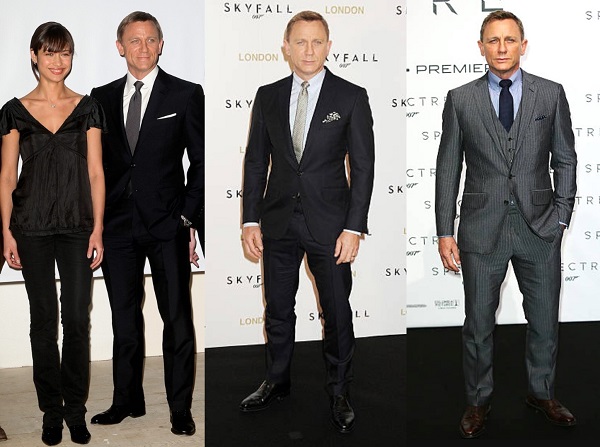
And of course I need to mention that having trousers shortened and hemmed is one of the easiest adjustments to make to suit. Most suit trousers actually come unhemmed specifically so you can get them tailored to the correct length. Just remember that with tapered trousers, the higher up you go on the pant leg, the wider the cuff opening will be. So it’s still a good idea to get trousers with an inseam length as close to your own measurements as possible.
Suits for the Affordable James Bond Wardrobe
Now that we know how to buy a suit, we need to decide what suits to buy. This is only my personal opinion. But I feel that unless you’re wearing suits everyday (or have disposable income to spend on more suits), you only need to start with two.
The Solid Dark Navy Suit
![]()
Bond has worn numerous variations of the navy suit during the franchise’s history, from solids to subtle birdseye (a Brosnan favorite) to herringbone to sharkskin in various shades of blue. However, I’m going to suggest staying with a solid, darker navy rather than patterned suiting. My ideal model would be Craig’s “Greene Party” suit from Quantum of Solace, but in something like a super 110s worsted wool. For this particular suit, I’d also lean more to a standard two button jacket. But a three-roll-two would also be acceptable.
Why navy for the first suit? Because it’s incredibly versatile. It can worn with a variety of shirt colors and ties. And it’s appropriate for almost any “dressed up” business setting. But it also works for social events like weddings or a special date night. As a foundation suit, it has the most to offer.
The Medium Grey Suit
![]()
The other consistent suit color choice for Bond has been medium grey, again used with a variety of suitings. It’s also a versatile color that works well with different complexions and shirt-tie combinations. It’s dark enough to be used for business. But light enough that you can wear it for social events in the summer when a suit and tie is required.
I think we can have a little fun with the fabric for this one. Personally, I’d choose a lighter weight pick and pick or sharkskin suiting, like the ones Bond wore in Thunderball, The World is not Enough and Skyfall. However, I’d still stay away from bolder patterns, such as glen checks or pinstripes, for my second suit.
Another advantage of going with sharkskin is we can use the trousers as alternatives for the Acne Studios Wall Street trousers Bond wore in Shanghai (with the Billy Reid peacoat) in Skyfall. Remember, versatility is the name of the game when you’re building an affordable Bond wardrobe!
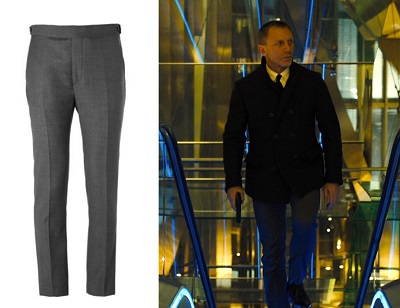
Some Final Thoughts
In today’s more casual world, it may seem like the suit has become almost the least important thing in a man’s closet. Many guys rarely wear one except for weddings and job interviews (or #menswear pics for Instagram). And even if you love wearing suits, it can feel awkward being the only “dressed up” man in a room filled with jeans and hoodies.
But I think it’s important to remember that James Bond’s relationship with suits hasn’t only been about the tailors and fabrics. Suits have been (and continue to be) an important part of his identity, a physical manifestation of his professionalism and a reflection of the care he takes with his appearance. The Suits of James Bond has an excellent article on how to wear a suit with James Bond’s mentality. I would only add that the fact that we so seldom need to wear a suit today only makes them more special. There are very few items of clothing that can boost a man’s confidence like a well-cut suit he knows he looks great wearing. So it’s definitely worth taking the time to find the right one.
The Affordable James Bond Wardrobe Series:
- How to Dress Like James Bond
- Shirts & Sweaters
- Pants & Belts
- Sport Coats and Outerwear
- Shoes and Boots (coming soon!)
- Details and Extras (coming soon!)
Do you have some suggestions or advice about suits for your affordable James Bond wardrobe? Let us know in the comments! And remember you can always find more Bond-style inspiration on our Facebook Page, Instagram Account and Pinterest Boards!
Some images used in this post were sourced from The Suits of James Bond and BAMF Style.
Any chance of finishing this series?
https://cortefiel.com/gb/en/men/blazers/false-plain-classic-fit-blazer/2336545.html?dwvar_2336545_color=10#prefn1=style&prefv1=CLASSIC&start=1
Recently picked up this – the matching trousers are in the description on the website – and it’s very nice for an off-the-rack suit. The blue is dark enough to work for formal occasions, without being uninteresting.
Which came first in history pleated trousers or flat front ones. I suspect it was pleated trousers. And if so, when and WHY did IT happen?
Thank you.